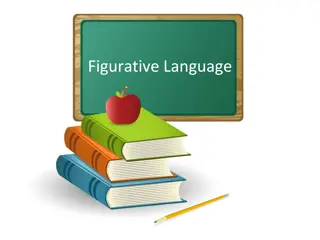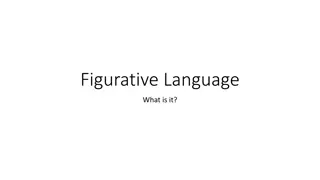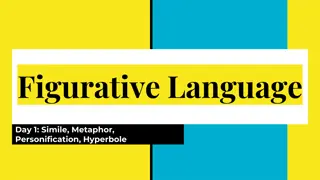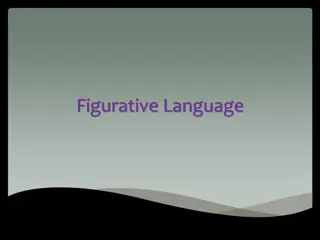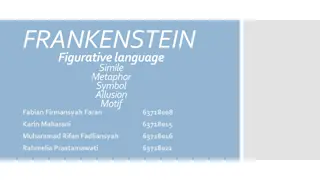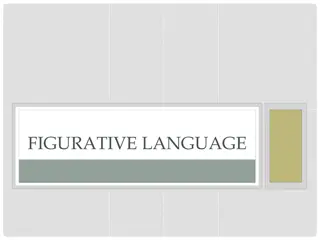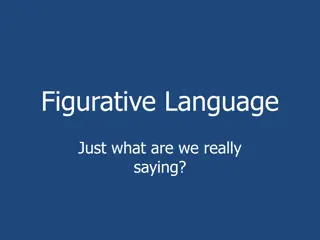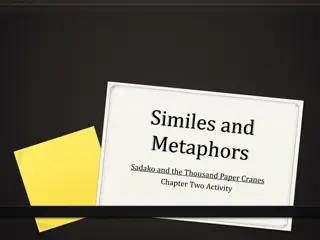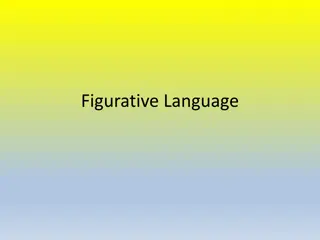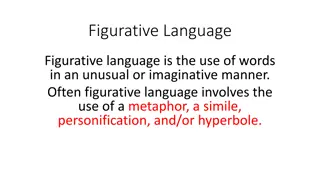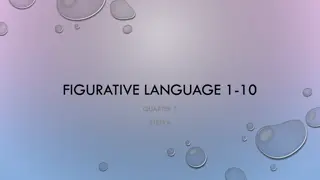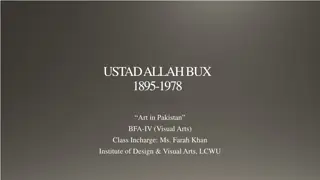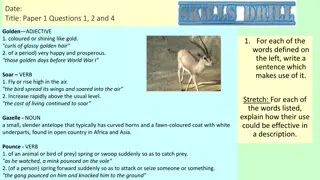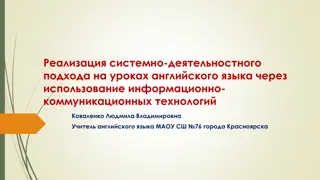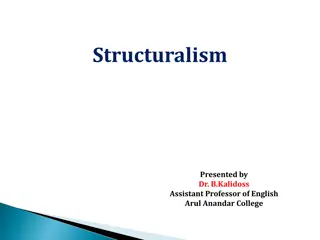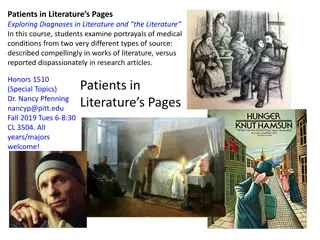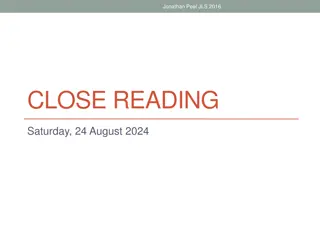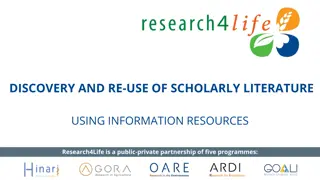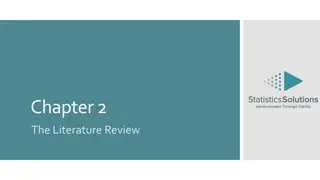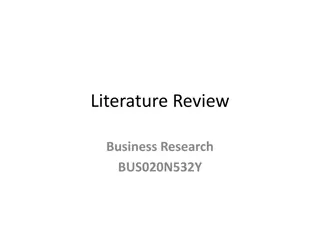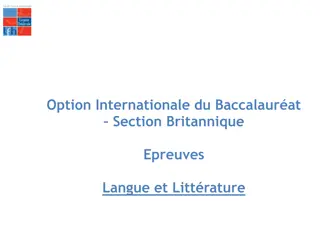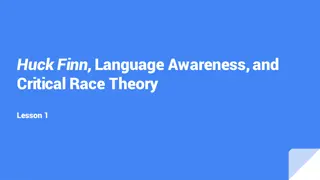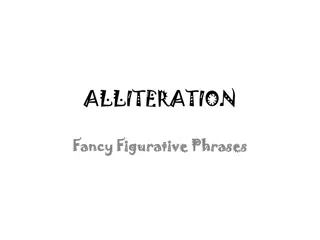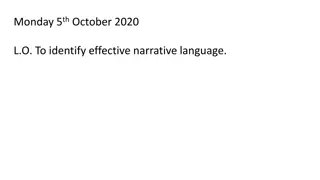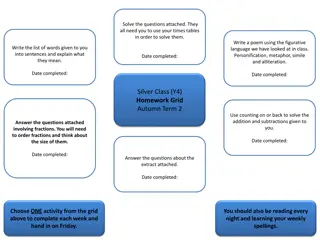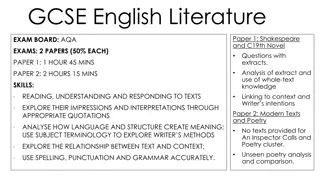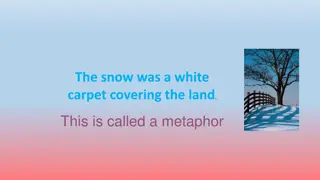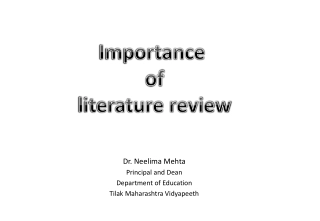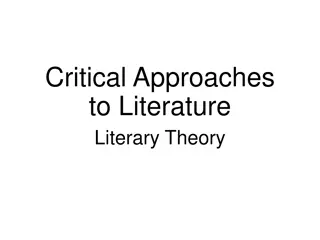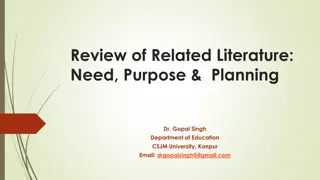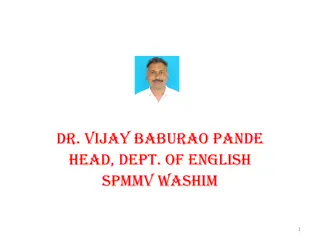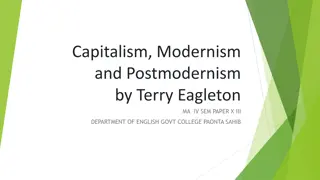Understanding Figurative Language in Literature
Figurative language adds depth and creativity to writing by using words in ways beyond their literal meanings. Examples include metaphors, similes, alliteration, and hyperbole. Poetry often employs figurative language to evoke sensory experiences and emotions. Allusions and idioms are also common forms of figurative language that require audience interpretation. Explore the world of figurative language through examples and explanations to enhance your literary understanding.
Download Presentation

Please find below an Image/Link to download the presentation.
The content on the website is provided AS IS for your information and personal use only. It may not be sold, licensed, or shared on other websites without obtaining consent from the author. Download presentation by click this link. If you encounter any issues during the download, it is possible that the publisher has removed the file from their server.
E N D
Presentation Transcript
figurative language figurative language (FIG-yer-uh-tiv LANG-gwidj): The literal meaning of a word is its definition as you would find it in a dictionary. Figurative language uses words in some way other than for their literal meanings to make a comparison, add emphasis, or say something in a fresh and creative way. Examples of figurative language include alliteration, hyperbole, idiom, imagery, metaphor, onomatopoeia, personification, and simile.
figurative language Figurative language
figurative language Poetry is a type of writing that uses figurative language to create images and ideas appeal to the five senses appeal to emotions
alliteration When two or more words in a group of words begin with the same sound (usually, the same letter or group of letters). For example: Anne s awesome apple; Fred s frozen french fries
alliteration Alliteration Grammar Song
allusion A figure of speech that makes a reference to people, places, events, or literary works directly or implying them. It is up to the audience to make the connection.
hyperbole hyperbole (hahy-PUR-buh-lee): Extreme exaggeration used for emphasis or effect; an extravagant statement that is not meant to be taken literally. For example: I almost died of boredom. Hyperbole is frequently used in humorous writing.
hyperbole Hyperbole
idiom An expression that cannot be understood from the meanings of its individual words. For example, it s raining cats and dogs is an idiom that means it s raining really hard but there is no way to know that from the meanings of its individual words.
idiom Idioms' Song Idioms
imagery Language that portrays sensory experiences, or experiences of the five senses: sight, hearing, smell, taste, and touch. Authors use imagery to describe actions, characters, objects, and ideas, and to heighten the emotional effect of their writing. One way authors create imagery is through the use of figurative language.
imagery imagery
irony There are three types of irony: (1) dramatic irony, when the reader or audience member is aware of something that the characters are not aware of; (2) situational irony, when something happens that is the reverse of what you expected; and (3) verbal irony, when the name or description of something implies the opposite of the truth (for example, calling a very tall person Tiny )
irony Irony Irony Video 1
metaphor The comparison of two unlike things to illuminate a particular quality or aspect of one of those things. For example, Karen was a ray of sunshine is a metaphor in which Karen is compared with a ray of sunshine. The metaphor suggests that Karen was cheerful, happy, warm, hopeful qualities we associate with the sun. Metaphors state that one thing is something else; they do not use the words like or as.
metaphor Metaphor Metaphor Video 2
onomatopoeia The use of words whose sounds imitate the sounds of what they describe, such as hiss, murmur, growl, honk, buzz, woof, etc.
onomatopoeia onomatopoeia
oxymoron An oxymoron is a figure of speech in which words or phrases that appear to express opposite thoughts are used in conjunction and describe a situation where both words or phrases are aptly applied.
oxymoron oxymoron
personification Describing nonhuman animals, objects, or ideas as though they possess human qualities or emotions. For example: The moon smiled down at her, I felt the cold hand of death on my shoulder, There is a battle being fought in my garden between the flowers and the weeds.
personification Personification
puns puns
rhetorical question a question asked in order to create a dramatic effect or to make a point rather than to get an answer. "the presentation was characterized by impossibly long sentences and a succession of rhetorical questions"
rhetorical question rhetorical question
simile When two unlike things are compared using like or as in order to illuminate a particular quality or aspect of one of those things. For example, Randy s voice is like melted chocolate is a simile in which Randy s voice is compared to melted chocolate. The simile suggests that Randy s voice is rich, smooth, sweet, warm qualities we associate with melted chocolate.
similes and metaphors simile
symbol An object, setting, event, animal, or person that on one level is itself, but that has another meaning as well. For example, the American flag is really a piece of fabric with stars and stripes on it, but it also represents the United States and ideals like freedom, patriotism, and pride. In a story or play, rain could be a symbol; the rain would really be rain, but it might also represent an idea like sadness or leaving the past behind. Symbolize means to be a symbol of.
symbolism The practice of using symbols.



